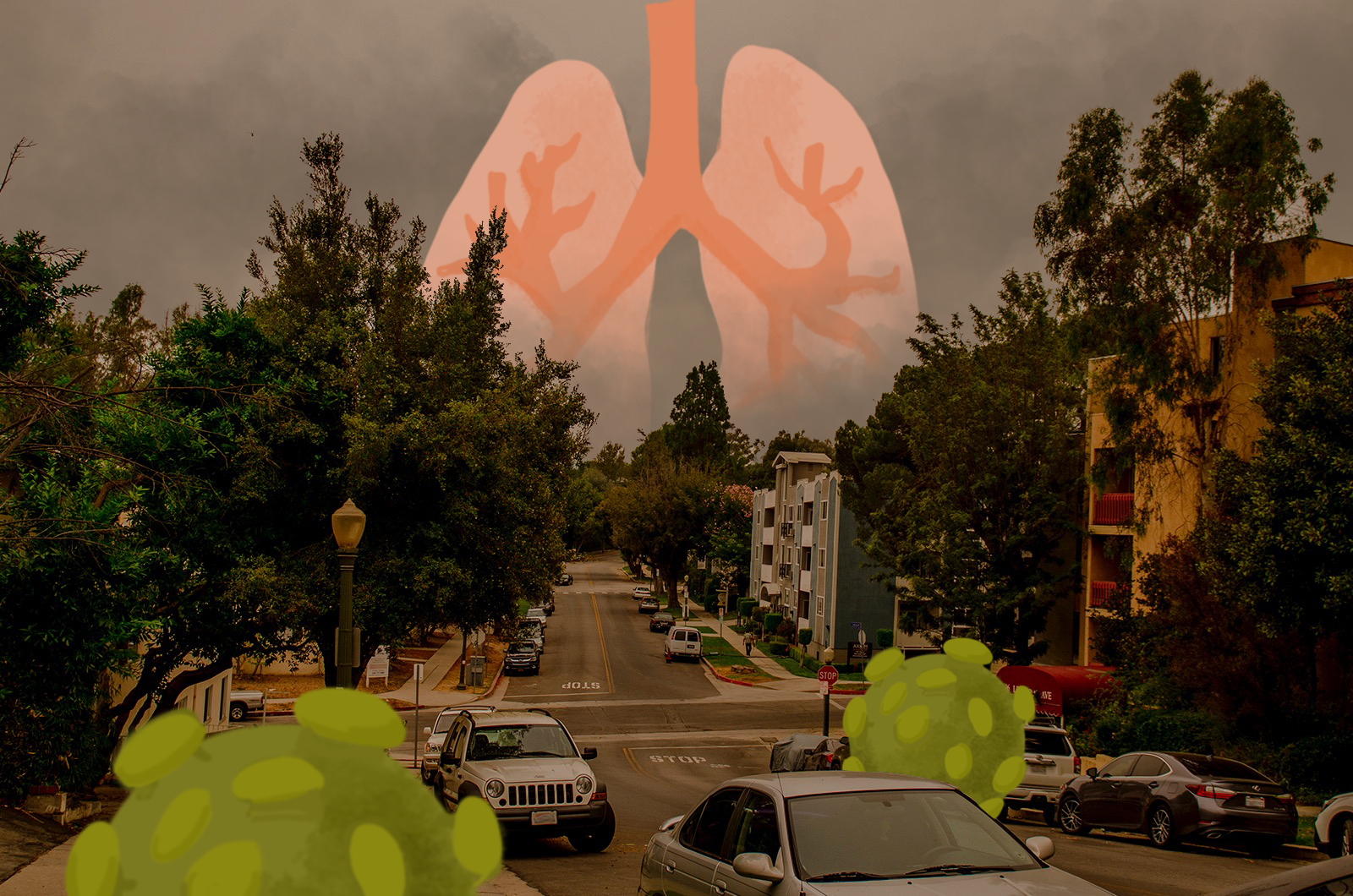UCLA, UCSF medical faculty say wildfires may exacerbate health effects of COVID-19

Increasing air pollution because of the recent wildfires poses a threat to lung health and may increase the chances of contracting COVID-19. (Photo by Kanishka Mehra/Photo editor. Photo illustration by Emily Dembinski/Illustrations director)

By Sarah Nelson
Oct. 14, 2020 1:26 a.m.
California’s wildfire smoke and COVID-19 could create an unforeseen mixture of adverse health effects for the state’s residents, UCLA medical faculty said.
Although little is known about long-term exposure to air pollutants like wildfire smoke and its particulates, there are preliminary studies that show the number and severity of COVID-19 cases are higher in areas with high air pollution, said Stephanie Christenson, a doctor and an assistant professor of pulmonology at UC San Francisco.
The short-term effects of exposure to wildfire smoke are more well known than long-term effects, Christenson said.
The first case of COVID-19 occurred nearly a year ago, according to the South China Morning Post. The virus attacks the lower respiratory tract and has the potential to permanently damage bodily organs, according to a guide on the virus published by Johns Hopkins University. While wildfires are not new to the region, the addition of such fires to the COVID-19 pandemic calls into question the impact of these paired natural disasters.
“In the setting of wildfires we see that hospitalizations for asthma, chronic obstructive pulmonary disease, heart and cardiovascular disease, heart attacks and stroke go up,” Christenson said. “During wildfire season, there is an increase in people getting hospitalized for more severe respiratory infections, such as acute bronchitis and pneumonia.”
Chronic obstructive pulmonary disease is caused by the damage the lungs have endured through what one inhales in a lifetime, said Christopher Cooper, a doctor and professor of medicine at the David Geffen School of Medicine.
“Your genetic makeup plus cumulative exposure to inhaled particulates and fumes leads to chronic inflammation, narrowing of the airways and eventual damage to the lungs,” Cooper said. “The California wildfires have polluted so much of the atmosphere that that pollution is going to last a considerable length of time.”
The mixture of unknown compounds and particles makes wildfire smoke unique, said Mark Morocco, clinical professor of emergency medicine at the School of Medicine.
“What it is, is a witches’ brew of particulates from unknown sources, possibly containing metals, hydrocarbons, organic compounds, carcinogens and toxic materials from buildings, dispersing particulates that are one-thirtieth the size of a human hair, or 2.5 microns in size,” Morocco said.
When wildfires burn, they release tiny compounds into the air that humans then breathe in, Morocco said. These minute particles can reach into the farthest recesses of the lungs, hitting the region of the lung composed of air sacs called alveoli, where the exchange of oxygen molecules one breathes in are deposited into red blood cells, he said. This causes the inflammation of the lungs, on top of irritation at the site of skin contact, Morocco said.
The finer the particles of smoke are and the duration of exposure are also factors that impact overall lung function, Morocco said.
There is some data suggesting that air pollution leads to an increased risk of asthma, COPD and cancer, Christenson said.
And because COVID-19 affects respiratory health, wildfire smoke on top of a case of COVID-19 could worsen the infection, Christenson said.
“So when you are exposed to weeks or years of consecutive bad air quality, there is a real concern for how this will affect you, as well as one’s risk for (COVID-19),” Christenson said.
The adverse effects on the lower respiratory tract, such as acute bronchitis and pneumonia, are caused by a lessened immune response, said John Balmes, a professor of medicine at UCSF. The immune cells of the lower respiratory tract responsible for clearing away foreign material become engulfed with wildfire smoke particulate matter, and are no longer able to aid in the immune response, Balmes said.
Inflammation in the lungs can also travel through the body and lead to other non-pulmonary organ injury, inflammation and cardiovascular disease, Balmes said.
Because lung function evolves from birth to early adulthood, there is a greater risk of developing COPD later in life, Balmes said.
According to the Centers for Disease Control and Prevention, people should stay indoors when wildfires are nearby, familiarize themselves with their risks, depending on whether you are pregnant or experiencing illness, etc., limit outdoor activities in smoky areas, wear N95 masks if you must go outside for long periods of time and use HEPA or MERV-13 air filters with indoor air-conditioning.
When you have air quality index levels of 150 or more, no one is immune to short-term impacts such as palpitations, runny nose, headaches, fatigue and dizziness, Christenson said, who recommended that people regularly check air quality index websites like AirNow that receive information from the Environmental Protection Agency.
“Just because the sky is not glowing orange or there is not a fire close by does not mean that the air is good to breathe,” Christenson said.

